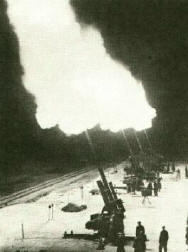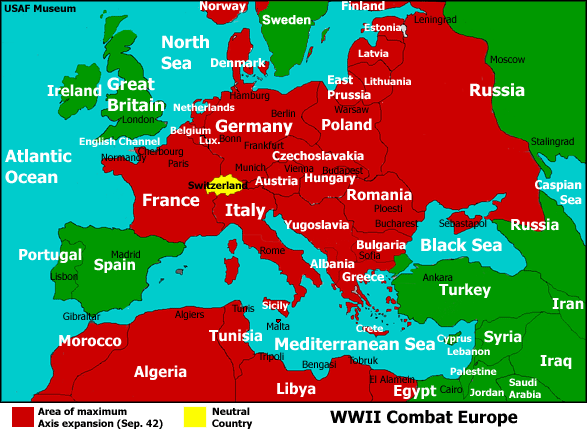Introduction to the Air War During WWII
Grasping the whole concept of such a massive war that depended so much on air superiority is a difficult task. There are many aspects to explore, and some concepts very odd. To say the least, WWII was a confusing time. Operations involving air units were often unorganized and done on a "whenever the CO (Commanding Officer) sees fit" kind of fashion. The success of missions often relied solely on the orders of the officers in charge and the strength of the aircraft. Introducing someone to the general ideas of what happened in the skies over Europe and the Pacific during WWII is no easy task, but hopefully this effort will be of some use. Below you will find some general information on the forces at work.
Major Air Forces
![]()
![]()
![]()
To start off, you will need a good idea of the four major air forces at work during WWII. There was the USAAF (United States Army Air Forces), RAF (Royal Air Force - British forces), Luftwaffe (German air force), and the Japanese Army Air Force or Navy (IJAAF or IJN). The countries participating in the air war were not limited to these forces, however. Hundreds of countries were participated.
Because America was not immediately dragged into the war by Hitler's blitzkrieg (blitzkrieg = German for "lightning war"), the RAF, or Royal Air Force was the first major force to go into battle against the mighty Luftwaffe. The Finnish, Polish, French, and Russian air forces already had a crack at the Nazi's flying regime, although they had not been extremely successful. In spite of being a small island country, the British were a strong people. The RAF proved to be brave fighters. During the Battle of Britain in 1940, Supermarine "Spitfires" of the RAF shot down hundreds of the Luftwaffe's Messerschmitt Bf-109's with the aid of radar. This radar system was new to the British and named the "Chain Home" radar system. Not only did the RAF fighters go up to meet the advancing Luftwaffe fighters and bombers, but they proved efficient on the offensive too. Nightly bombing raids on German cities and military installations was commonplace, and was designed to break the will of the people to fight. The British had originally tried daylight precision bombing, but found the losses too heavy. The bombing did not hault the growing of the Reich, but severely terrorized the people. It also stalled the German war effort of production, and gave the Allies a slight edge. With waves of fighters meeting single German planes that entered British airspace, the Luftwaffe were pushed back to the defensive position. Rings of defensive "flak" guns were set up in Germany to stop the bombers. "Flak" guns shot shells high into the air that exploded with shards of metal flying in all directions. This could literally rip a plane apart, or do massive damage. The flak guns were a large threat to Allied aircraft, during day or night operations.


Above: German 88mm Fliegerabwehrkanonen, or "Flak" guns for short. Click here for more on flak guns.
Prior to the outbreak of war in Germany, the USAAF was known as the USAAC (United States Army Air Crops). The name was changed to the USAAF (United States Army Air Forces). At this time in history, the air force was not present as an independent military unit. It was under control of the US Army. The USAAF proved to the world America's power in the aircraft industry during WWII. The massive production of aircraft during WWII has carried the USA into the spot as a major manufacturer of aircraft, by companies such as the widely-recognized Boeing and Lockheed corporations. The concept of the mass production that occurred during WWII is hard to believe. Different companies actually worked together to make one airplane; something never seen in today's manufacturers. The factory workers on the home front were as important to the war effort as the soldiers on the beaches. Great fighters such as the world-famous P-51 Mustang, the P-38 Lightning, P-40 Warhawk, F4U Corsair, and more were produced in the USA and used by Allied forces everywhere. Bombers such as the B-17 Flying Fortress, B-24 Liberator, B-29 Superfortress, and B-25 Mitchell claimed fame across the globe. These warbirds helped win the war, and did a superb job at it too. Many of the famous aircraft covered in the next sections were produced by the major American companies of Boeing, Curtiss, North American, Consolidated, Bell, and Republic.
The pride and power of the Nazi regime, the Luftwaffe was deadly to Allied air forces. Their bombers were not successful in most occasions (due to high loss rates) but the fighters scored innumerable kills on Allied bombers. American B-17's and British Lancasters were big sitting ducks in the sky. Some kills were scored with the bomber's machine gun defenses, but a quick burst from a Luftwaffe Messerschmitt Bf-109 or Focke-Wulf 190 could mortally wound the slow bombers. Most of the American and British bombers did not survive the swift attacks from the Luftwaffe fighters, especially if they had already met the outer-ring of German flak guns protecting Germany. Many thought the powerful Luftwaffe would lead Germany to a grand victory before American fighters entered the picture.
The Luftwaffe was commanded by Hermann Göring; ace of WWI. Towards the end of the war, the Luftwaffe slowly disintegrated with the rest of the Nazi power, but a small come back was made with the war's first jet fighter, the Messerschmitt 262. If Hitler hadn't made his grand blunder with his insistence that the Messerschmitt 262 be a more powerful fighter-bomber, this aircraft could have turned the tide of the Allied victory. The few Me-262's that were used primarily as fighters had extremely high kill rates against bombers and fighters alike. Thankfully, the shortage of available Me-262's and their late entry into the war let the bombing campaign go unstopped. The Luftwaffe crumbled with the rest of Adolf Hitler's Third Reich.

After the massive bombing on December 7th, 1941 of Pearl Harbor, the US was clearly aware of the Japanese air strength. (See below for audio files). The mighty Mitsubishi A6M2 "Zero" was deadly to US naval fighters and torpedo/attack aircraft. They were swift and carried quite a firepower punch. Although the Japanese aircraft were deadly, they were gradually surpassed by new American planes. As Japanese death rates rose, a new idea was implemented. Commonly known as "Kamikazes" , these suicide pilots would dive bomb US ships with aircraft full of explosives. These pilots were extremely honored by the Japanese and operated under a special code of conduct called the "Bushido code." The basic thing to know is that the Japanese air forces started off strong but gradually lost their effectiveness. However, tough fighting was still present on the ground during the US "island hopping" campaign to stop the Japanese advance. Before the US was forced to invade Japan, atomic bombs were dropped on the cities of Hiroshima and Nagasaki by US B-29 Superfortress bombers. Millions of Japanese lives were lost, and the surrender came almost immediately after the attacks. The USAAF had planned several more atomic bomb drops had two not been adequate.

Click Here to do to the downloads section for Pearl Harbor clips, aircraft sounds, movies, and desktop wallpaper!
